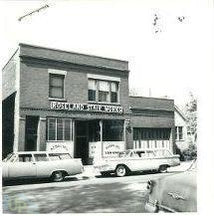Experts in Making Staircases Grand

Experts in Making Staircases Grand
Yes, kids, math does matter, at least if you plan to become a stair builder.
“Radius, tangent, sine and cosine,” said Dave Lautenbach of Orland Park. “Years ago, I called my high school math teacher with a question. Now, I keep a cheat sheet.” To make stairs safe, Lautenbach explained, a stair builder must mind his numbers, not to mention building codes. They dictate everything from tread width to baluster height Lautenbach co-owns a stair company with his siblings Kris, Ken and Lars, along with their father, Ken.
The company name is a nod to the Chicago neighborhood where his great-grandfather bought the company in 1914. Roseland's projects range from $2,000 sensible stairs to $130,000 flights of fancy. Their most elaborate, said Lautenbach, is a free-standing double staircase that floats into a New Lenox foyer. Ideally, said Lautenbach, a client calls when his new house or remodel is in the blueprint stages.
"Then it's not too late to correct problems, like a too narrow staircase," he said,
If the client is remodeling, Lautenbach checks to see if the existing staircase is sound, if it includes any load-bearing walls and if it meets code. "If it is a staircase to a basement that's being finished, I ask if they want it open at the top and check if that's possible structurally" he added.
Each sibling walks a client's project through from design to completion. Some clients have specific designs in mind, while others look to Lautenbach for direction. "We've replicated staircases from magazine pictures and from
photos of historic homes," said Lautenbach.
Roseland's Orland Park showroom includes component samples and pictures of stairs the company has built for clients across the United States and in Europe. Stair trends cycle back, noted Lautenbach. " Just when we thought we had taken out all of the old iron balusters from the 1960s they came back in style," he said. "Now half the clients want wood, half want iron. About 5 percent want glass, wire or stainless steel; usually in contemporary houses,"
Lautenbach draws each staircase by hand. 'Software doesn't know for example, that an existing wall isn’t plumb,” he said. “Doing it by hand forces me to think it through.”
Lautenbach considers the client’s lifestyle with each design. “If you have young kids, think about a carpet runner down the middle for safety. You can always change it later,” he said. “Older people should have plenty of light. Add wall sconces or tread lights if there’s no natural light.”
After Lautenbach and his client agree on a design, his crew fashions the staircase pieces in their shop. “It arrives on the job site ready to be assembled,” he said.
A typical installation takes three to seven days, begins with attaching the stair stringers to the wall. Treads and risers attach to the stringers to form steps. Add balusters, banisters and newel posts, and a stair is born.“One of our trademarks is the newel post that’s integrated into the stair,” said Lautenbach. “It gives the staircase added strength.”
Off the job, Lautenbach devotes his time to Christian service, including a mission trip to Haiti he made in November. The names of his five children reflect his beliefs. His son, Jeremiah, was named
for the prophet. His daughter, Hope, was named for the Jeremiah verse that buoyed him through the death of a child and his first wife, said Lautenbach. “He doesn’t promise life will be a cakewalk, but he says there will always be hope,” he said.
When the company moved to Orland Park in 1976, the Lautenbach family donated their Chicago building to a ministry that turned it into the Agape Community Center. When the company moved to a larger facility in Orland Park, it turned over its former building to Elim Christian Services. Lautenbach’s own house has a wood staircase with simple lines that reflect his favored prairie-style.
“I wouldn’t model Frank Lloyd Wright’s lifestyle,” he said. “But I do appreciate his work.”
Q: What’s the tool you cannot live without?
A: My iPhone. I can check my calendar, show clients pictures from our portfolio and check my email.
A: Staircase, stairway. Spindle, baluster. It’s tomAYtoes, tomAHtoes to me. A staircase is a mix of about 175 to 200 parts, so the client has a lot of decisions to make. What’s important is that I make it as painless as possible.
A: Building codes dictate a lot about staircases, but not how many stairs you must have. But it’s pretty consistent because of riser height rules. So for a house with a 10-foot ceiling, it’s almost always 17 steps.
- David Lautenbach


